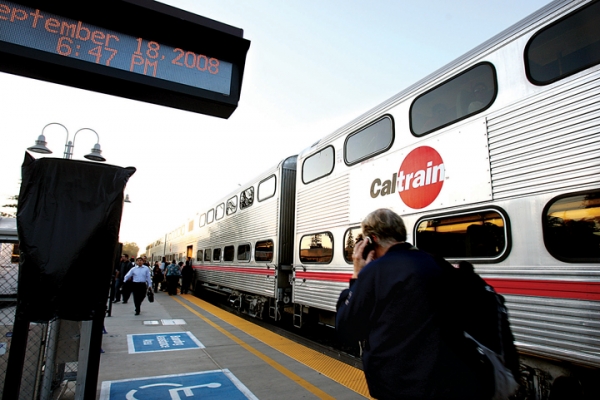Caltrain's effort to upgrade its train service surged ahead Thursday when the Federal Railroad Administration awarded the cash-strapped system a $16 million to design a modern signaling system.
The funds would be used to design a "positive train control" system -- a GPS-based system that would allow Caltrain to more efficiently monitor and control trains. The signal system automatically slows down trains when they reach close proximity, prevents derailments and ensures trains don't go into zones where work is being done on the rails. All rail systems in which passenger trains share tracks with freight are required by federal law to install positive control by 2015.
The signaling system would also allow Caltrain to run more trains up and down the Peninsula -- a key objective of the popular train service that carries 41,000 people per day. Caltrain announced that it will allow "train movements and schedules to be coordinated more efficiently" and enable the ultimate operation of high-speed rail on the Peninsula.
U.S. Rep. Anna Eshoo, who helped arrange the federal grant, called the award an "important victory" for Caltrain and for her constituents on the Peninsula. Though the awarded funds are far short of what is needed to install positive train control -- a project with an estimated price tag of $250 million -- Eshoo said the grant represents a commitment from the federal government to modernize the train system.
"The $16 million doesn't cover all the costs, but this is the bridge that will get us to complete the design," Eshoo told the Weekly. "That's why it's so important -- it's an improvement for safety and efficiency.
"It's a significant step to upgrade Caltrain."
The signaling technology is a key component of what Eshoo, state Sen. Joe Simitian and state Assemblyman Rich Gordon described in April as "21st Century Caltrain." The concept also includes new train stock and a switch from diesel to electricity. The Peninsula Corridor Joint Powers Board, which oversees Caltrain, has been working on the environmental analysis for an electrified system and hopes to have the document certified this summer.
Eshoo has been working since spring 2010 to allocate federal stimulus money for Caltrain improvements. In May 2010, she sent a letter to U.S. Secretary of Transportation Ray LaHood, requesting an allocation for positive train control on the Caltrain corridor. LaHood finalized the deal with the California High-Speed Rail Authority this week.
In a prepared statement, LaHood said keeping people safe is the department's "top priority, and positive train-control technology will ensure California's rail network transports passengers more safely and efficiently than ever before."
"This comprehensive safety technology will improve passenger service along the highly traveled corridor between San Francisco and San Jose and will ultimately benefit the entire high-speed rail system in California."
Caltrain officials welcomed the announcement, with Executive Director Mike Scanlon calling it "an important step forward in our efforts to provide Bay Area communities with a modernized, sustainable commuter rail system that is fully compatible with future high-speed-rail service." Though the proposed rail system is scheduled to launch in Central Valley, it would ultimately be extended to the Peninsula along the Caltrain corridor under current plans.
"The Administration and our Congressional leaders should be applauded for recognizing the importance of optimizing safety and promoting integration with regional systems as we continue to plan a project that will transform the way Californians travel," Scanlon said in a statement.



Comments
Rex Manor
on Jun 24, 2011 at 7:02 pm
on Jun 24, 2011 at 7:02 pm
Positve Train controls---first time I heard of such a thing. CalTrain does need the upgrades. Then comes electrification. Then if we are real lucky, then we may see HSR up and down the Peninsula while I am still alive...
Old Mountain View
on Jun 25, 2011 at 4:14 pm
on Jun 25, 2011 at 4:14 pm
Looks like a step in the right direction, I would love to see those old diesel engines put out to pasture too.
Shoreline West
on Jun 28, 2011 at 9:15 pm
on Jun 28, 2011 at 9:15 pm
Pork, pure and simple. Allow for more trains to be run? Isn't CalTrain cutting service? Freight does not run on these tracks. Stop spending our money on unnecessary capital upgrades if you're cutting service.